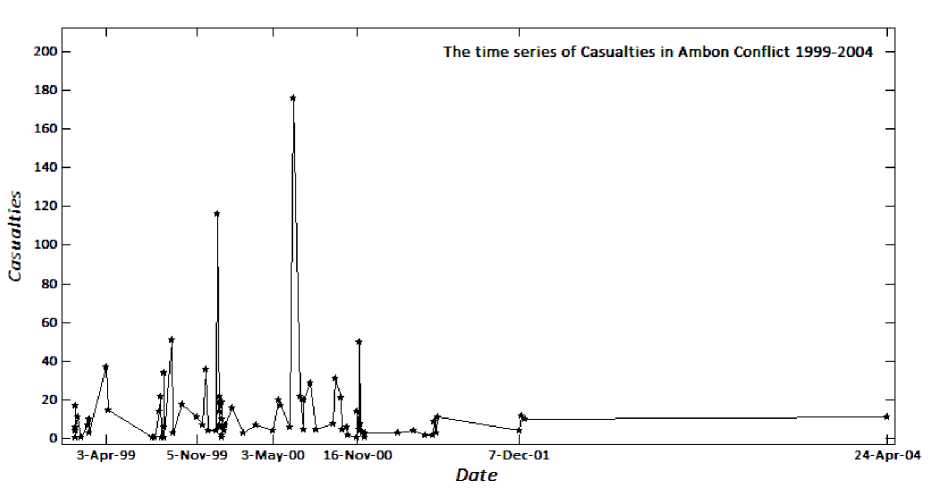the vigorous state of violence and people were got killed, houses were burnt, the city,
business, and economic activities collapsed. The conflict seemed to be contagious even up
to the northern islands in Halmahera.

Figure 2. The casualties in the long time conflict in Ambon
2. On Power Law in the Mass Conflict’s Casualties
Many analyses have been delivered in order to explain the massive conflict and civil
violence and the motive of the paper is to bring a slightly different approach to the empirical
data of the conflict while modestly trying to build an alternative possible explanations.
Obviously, one important step to prevent more severances in conflict and violence is by
understanding some properties of the conflict, be it from macro-views or the micro-states of
social actors emerging the observable properties of the social system. This is what we want
to present in the paper.
One of the interesting feature of the quantitative analysis on social conflict and wars
- yet frequently overlooked and not frequently cited - were once introduced by English
physicist and meteorologist, Lewis F. Richardson (1948). He showed that the sizes of war
casualties in the world were following the simple multiplicative process, known as the
power law. Richardson’s calculations depicted that for each ten-fold increase in severity, the
frequency decreased by somewhat less than a factor of three. An interesting and detailed
quantitative approach was thus conducted by Cederman (2003) to see more theoretical
implications of the revealed fact. This is an interesting fact for in some other cases, the
power law has also been discussed to be present in a lot of other scientific domains and
observations (cf. Situngkir, 2003 or the detail with various data in Newmann, 2005).
More intriguing information
1. Ongoing Emergence: A Core Concept in Epigenetic Robotics2. Are Japanese bureaucrats politically stronger than farmers?: The political economy of Japan's rice set-aside program
3. Labour Market Flexibility and Regional Unemployment Rate Dynamics: Spain (1980-1995)
4. DEVELOPING COLLABORATION IN RURAL POLICY: LESSONS FROM A STATE RURAL DEVELOPMENT COUNCIL
5. Synthesis and biological activity of α-galactosyl ceramide KRN7000 and galactosyl (α1→2) galactosyl ceramide
6. Exchange Rate Uncertainty and Trade Growth - A Comparison of Linear and Nonlinear (Forecasting) Models
7. Opciones de política económica en el Perú 2011-2015
8. The name is absent
9. Recognizability of Individual Creative Style Within and Across Domains: Preliminary Studies
10. The name is absent